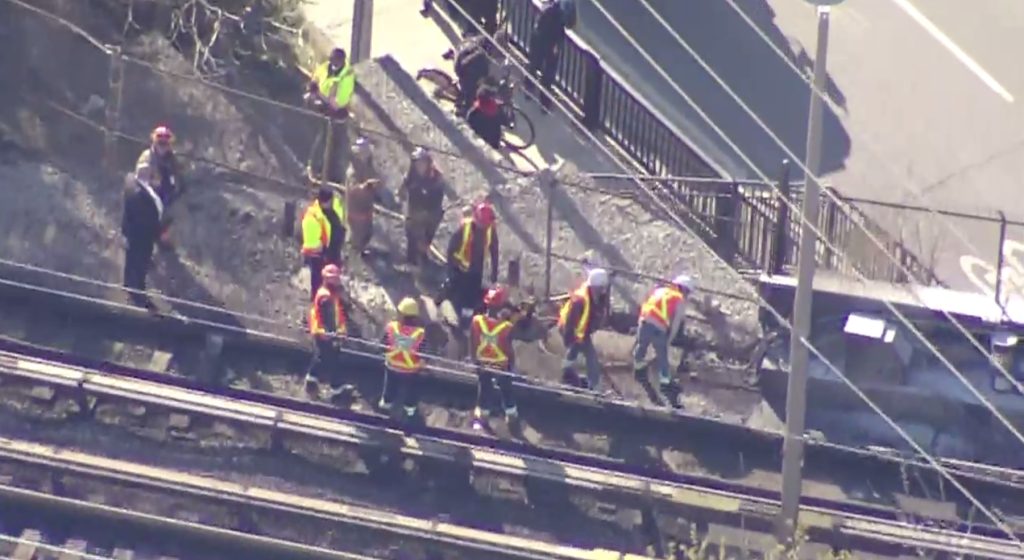Ottawa and Ontario must fund plan to build transportation to Ring of Fire: study
Posted February 21, 2014 7:00 am.
This article is more than 5 years old.
The federal Conservatives should make the Ring of Fire a national priority and take a “more active role” in developing the mineral-rich region in northern Ontario, which could yield billions in tax revenues and economic activity, a new report recommends.
Ottawa has an obligation to be actively involved as it has for other projects, such as the Alberta oilsands and the Churchill Falls hydroelectric project in Labrador, the Ontario Chamber of Commerce said in a report released Thursday.
But it seems to be taking a more “passive” role, with Prime Minister Stephen Harper saying it’s a project that “is primarily under provincial jurisdiction,” the report said.
However, Ottawa has the most to gain in terms of tax revenues from the project, it added.
“If for no other reason, the federal government has a strong financial incentive to be a much more active player in the development of the Ring of Fire,” it said.
The lack of a transportation route is a major barrier to developing the region, which could generate up to $25 billion in new economic activity over the next three decades, the report said.
The Ring of Fire could generate $9.4 billion over the next decade alone and support 5,500 jobs a year, it said. It would also provide the federal, Ontario and municipal governments with almost $2 billion in revenue over that period and $6.7 billion over 32 years.
But there’s a significant infrastructure gap, a shortage of skilled labour, a need to finalize partnerships with aboriginal communities and new technologies to minimize the environmental impact of developing the area, it said.
The federal and Ontario governments must commit funds dedicated to building the infrastructure that’s needed, the report recommends.
“At a minimum, (the federal government) should match any provincial investments in Ring of Fire infrastructure,” it said.
The Ontario Liberals, who are establishing a development corporation to bring all the parties together, say they’ve been asking Ottawa for months to commit money to developing a transportation route.
They’ve asked Harper to pay for half the $2.25-billion estimated cost of building both roads and industrial infrastructure.
But there was no mention of the Ring of Fire in last week’s federal budget, although it did highlight financial support for other infrastructure priorities, such as Toronto transit.
Greg Rickford, the federal minister responsible for the file, has said it’s up to Ontario to apply for infrastructure funding under the new Building Canada fund.
But the province says it’s insufficient as Ontario’s share of the fund, which is aimed at supporting all kinds of projects, is $2.4 billion over 10 years.
“It’s time the federal government do for Ontario what it has been doing for other provinces,” said provincial Natural Resources Minister David Orazietti.
“I think it does fall short and I think the federal government really needs to come to the table on this.”
Ottawa has put over $500 million into oil investments in Western Canada and over $6 billion in a loan guarantee to Newfoundland-Labrador, he said.
“This is the kind of investment that we as Ontarians need to see in a multi-generational investment in the range of $60 billion,” said Orazietti, who represents the northern riding of Sault Ste. Marie.
“So we’re prepared to step up, but we also need to see an investment from the federal government, which they have yet to commit to.”
The Ring of Fire is believed to contain one of the largest chromite deposits in the world, a key ingredient in the making of stainless steel.
It’s a significant find given the growing demand for chromite, particularly in China, which is a leader in the production of stainless steel, the report said.
“Only one per cent of Ontario’s exports are destined for China,” it said.
“Ontario’s aggregate exports to China would rise significantly were it to produce ferrochrome or export raw chromite.”
The project suffered a major setback in November, when a big mining company that was going to pour $3 billion into the Ring of Fire suddenly pulled out.
Cliffs Natural Resources Inc. suspended its operations indefinitely, saying it couldn’t keep spending money while the question of whether it would be able to build an all-weather road to the remote site remained in doubt.
Cliffs has gone from 85 people down to about six, whose sole job appears to be packing things up, said Progressive Conservative Vic Fedeli, who visited the Ring of Fire recently.
Noront Resources, which has the Eagle’s Nest nickel-copper project, has about six workers there, down from over 100, he said.
But Noront is still in play and proposed an east-west route to transport nickel — the “low-hanging fruit” that could be mined as soon as this fall — as opposed to the north-south road Cliffs had advocated, he said.
“Start putting some scores up on the board while we look at the bigger more complex issue of chromite development and getting the chromite out,” Fedeli said.
Noront estimates it could cost about $400 million to build a road from the Ring of Fire in the James Bay Lowlands to Webequie, then use an existing winter road to the town of Pickle Lake where it could access a railway.










